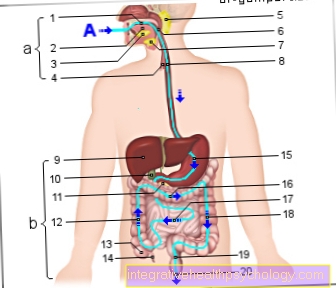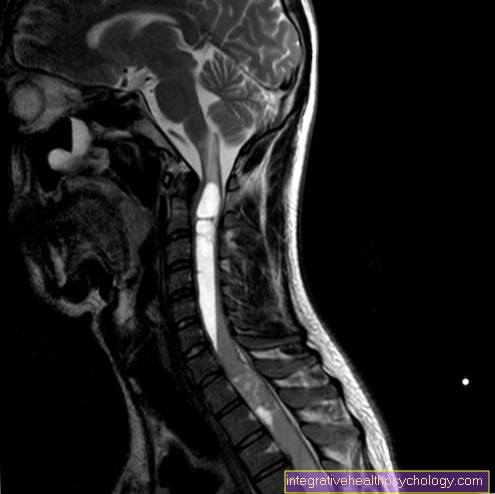Cefuroxime and cephalosporins
General
The cephalosporins and, as the main representative, cefuroxime are classic broad-spectrum antibiotics and, like penicillins, belong to the group of beta-lactam antibiotics. They have a bactericidal effect, i.e. they kill bacteria by disrupting the bacterial cell wall synthesis.

Classification
The antibiotic Cefuroxime belongs to the antibiotic group of Cephalosporinsthat to the Beta-lactam antibiotics are counted. Chemically, cephalosporins are derived from aminocephalosporanic acid. They are insensitive to an enzyme produced by different ones bacteria is formed and attacks the beta lactam ring compound (beta lactamase). The cephalosporins are not all equally insensitive to this enzyme. This property is used when using this group of antibiotics and takes cephalosporins with less sensitive beta-lactamase susceptibility to combat beta-lactamase-forming bacteria. The cephalosporins are found in four groups divided (1,2,3a, 3b). Cefuroxime belongs to the second group. This group includes antibiotics that are used parenterally, i.e. through an infusion. The main reason is, on the one hand, a faster effect this way and, on the other hand, the acid instability of this antibiotic. If an antibiotic is acid-stable, it can be given in tablet form via the stomach. It only takes effect after it has been passed through the stomach. Acid unstable antibiotics would be released instantly in the stomach Stomach acid can be dissolved and therefore not work properly. For this reason, an infusion directly into the patient's venous blood system is necessary. Cefuroxime is also available under the trade name ZinacefR. known. Group 2 of the cephalosporins is also known as the cefuroxime group, as this substance represents all of the antibiotics in the group. In addition to cefuroxime would be Cefotiam, under the name of Spicef Rand Cefoxitin under the name of MefoxitinR known to call. A further division apart from groups is made in generations. Newly developed antibiotics are called next generation antibiotics. Conversely, however, the effect is not necessarily better and when choosing antibiotics, the mechanisms of action and the bacterium to be combated are decisive. The cefuroxime group used to be known as intermediate cephalosporins or second generation antibiotics.
effect
Cefuroxime and all other antibiotics in this group have a bactericidal effect on fast-growing ones Germs (proliferating germs). All beta-lactam antibiotics have a so-called beta-lactam ring in their chemical structural formula. This disrupts the formation of the bacterial cell wall and thus destroys the bacteria. This ring is roughly the shape of a stop shield that is incorporated into the chemical structure of the antibiotic.
Side effects
Discomfort of the gastrointestinal tract as well as allergic reactions must be feared. A simultaneous administration of penicillin, should be avoided because of a possible cross allergy. In particular, patients who are known to be allergic to penicillin should not be given cephalosporins. Damage to the surface of the red blood cells (erythrocytes) can be observed at times. This means that a test that is primarily used to diagnose blood disorders can turn out positive (direct Coombs test). If this test is positive, an autoimmune disease can be suspected, as it primarily detects antibodies on the surface of the red blood cells. In any case, if the test is positive, the patient should be asked whether appropriate antibiotics are being taken. All other side effects, such as alcohol intolerance or an increased tendency to bleed are more likely to be observed with other cephalosporins and not with cefuroxime.
Please also read our article on this Antibiotic side effects
Areas of application
Cefuroxime is good but weaker than the antibiotics from the cefazolin group against gram-positive bacteria. However, they work better than antibiotics of the cefazolin group against gram-negative bacteria. The bacteria of the gram-negative range include, among others Enterobacteria, e.g. E. coli, Klebsiella, Proteus, Salmonella, Shigella and Haemophilus Influenza. The gram-positive pathogens include staphylococci and streptococci A and B. Cefuroxime is resistant to penicillinase against staphylococci and, to a limited extent, beta-lactamase-resistant to gram-negative bacteria, but there is a so-called Pseudomonas enterococcal gap. This means that cefuroxime cannot adequately combat these germs. For this reason it is a combination with Azlocillin and Piperacillin makes sense.
Cefuroxime is mainly used in so-called calculated antibiotic therapy for urinary tract infections and in hospitals Pneumonia (nosocomial) used, i.e. in the case of immediate antibiotic treatment without precise pathogen detection. In addition, cefuroxime is used in the treatment of prophylactic antibiotic treatments during surgery, in severe soft tissue infections and in the fight against the bacterium Haemophilus influenza.
Interactions
Antibiotics, which have a growth-inhibiting effect on bacteria and are taken in parallel, can weaken the effect of cefuroxime. For this reason, it should not be combined with Tetracyclines, Sulfonamides, Erythromycin or Chloramphenicol respectively. If cefuroxime is taken together with aminoglycoside antibiotics or dehydration drugs from the group of loop diuretics, there is a risk of kidney damage. If cefuroxime is taken together with blood-thinning medication (anticoagulant), the blood-thinning effect is increased and there is a risk of increased bleeding tendency with skin haemorrhage. The middle Probenecid increases the effect of cefuroxime when taken at the same time. By impairing the estrogen cycle, cefuroxime can weaken the effectiveness of oral contraceptives ("pill") and even cancel it out completely.
Contraindications
With an existing cephalosporin allergy and with a Renal failure cefuroxime should not be taken.



















.jpg)









